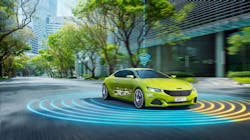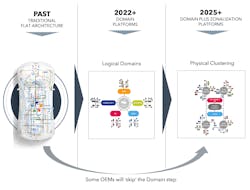The Software-Defined Vehicle Revolutionizes Auto Development
What you’ll learn:
- The first step toward the SDV was to logically group functions within the vehicle, like communication, body and comfort, and advanced driver-assistance systems and autonomous driving, into domains that are isolated from each other, and connecting them to the cloud.
- Architecture designs targeting 2025 model years are taking on a more zonal focus, i.e., physically partitioning the vehicle into zones.
- Domain plus zonalization architectures for SDVs leverage the software investment across the domains and ease software upgrades, enabling improvements over time through over-the-air (OTA) updates and introducing new revenue streams.
- Industry alignment and collaboration are crucial for SDV success hence forming the Scalable Open Architecture For Embedded Edge (SOAFEE), Connected Vehicle Systems Alliance (COVESA), and Eclipse Foundation.
The automotive industry is undergoing a huge transformation on multiple fronts as carmakers invest in more autonomous, connected electric vehicles (EVs) with future-proof capabilities that update various systems through their lifetime over the air (OTA). The software that runs on new electrical/electronic (E/E) architectures must be designed in innovative ways to support all of these significant investments, resulting in a dramatic shift from a hardware-centric to a software-defined vehicle (SDV) approach.
This article looks at how this multifaceted transformation is affecting automotive development on a variety of levels, including hardware, networking, and software development, while also utilizing the cloud during vehicle development and providing support throughout its lifecycle. Let’s take a look under the hood.
Massive Automotive Transformation with a Software-Defined Approach
We’re experiencing a revolution in the automotive industry that will dramatically change future vehicles for everyone. Carmakers quickly realized that their traditional flat E/E architectures wouldn’t scale through incremental electronic control units (ECUs) and meet the processing and data bandwidth needs of connected, autonomous, shared, electric vehicles (CASE) mobility.
Security was also a great concern. Any malicious hack of one of these boxes could lead to serious safety issues. To move the industry forward, OEMs have taken the more dynamic and software-defined approach used in everyday products like smartphones.
Today, the OEM’s first step toward the SDV is to logically group functions within the vehicle into sections that are isolated from each other. This isolation in the domain architecture brings an additional level of security, where the central gateway controls the data flow with the domain controllers. It involves the logical consolidation of functions, like communication, body and comfort, and advanced driver-assistance systems (ADAS) and autonomous driving (AD), and connects them to the cloud (see figure).
As we move forward, new architecture designs targeting 2025 model years are taking on a more zonal focus. Instead of the logical partitioning of functions used in the domain approach, the new approach is based on physical partitioning into zones. Another key benefit for the OEM to move from a flat architecture to a domain or zonal architecture is simplifying the complexity of the wiring harness, reduce its size and weight, and lower manufacturing costs.
OEMs can benefit from shifting the ECUs to software modules with a unified software architecture that spans functional domains in zonal gateways. Instead of multiple investments for each hardware box, OEMs can leverage the software investment across the domains. This zonal focus significantly eases hardware and software upgrades.
As everything from the driver’s user experience to the vehicle’s performance and range is defined by software, improvements over time are possible through OTA updates. Upgrading to self-driving or increasing the performance could even add value to the vehicle.
Challenges Ahead: From Software Engineers to More Cloud Dependence
A perfect storm of technologies is brewing to enable the SDV. Firstly, high-performance, automotive-qualified processors or systems on chips (SoCs) consolidate dozens of processors and capabilities. Typically, OEMs would have a powertrain engineer, a body and comfort engineer, and an infotainment engineer all working in their own silos, but now some of these functions are performed on the same processor.
Then there’s high-speed networking and wireless connectivity with 5G networks and Wi-Fi 6 and working with cloud providers. Here, the maturity of the cloud infrastructure and cloud-native software and tools are really crucial to make the SDV a reality.
Within these vehicles, significant advances have been made in automotive Ethernet technology. We’ve moved very quickly from 100 Mbit/s to 2.5 Gbit/s and 10 Gbit/s is now coming. Such multi-gigabit Ethernet with time-sensitive networking (TSN) can ensure the quality of service (QoS) and ability to share data across the vehicle.
Of course, the machine-learning (ML) aspect is being integrated into these vehicles, which also requires the cloud. It involves the continual cycle of live data to improve models within the vehicle through its lifetime and deploy new algorithms. To add salt to the wounds, the new cybersecurity regulations and standards must be considered, which relate to OTA management and intrusion detection and logging.
The influx of these new technologies presents a big challenge for OEMs with huge investments, dedicating thousands of software engineers to SDVs. There’s also a shift to new development methodologies and continuous integration and continuous delivery (CI/CD) with heavier reliance on cloud and large software integration.
More challenges abound, from reorganizational changes that break down the silos of communication because functions across the vehicle are being consolidated, to new talent acquisition, to developing new end-to-end IT systems.
But there’s hope. Although many different approaches can be taken with SDVs, there’s an underlying need for more industry alignment and finding a way to promote cross-platform services. We don’t want to reinvent the wheel—it would be very costly and may make any progress the industry must achieve with SDV development grind to a halt.
Collaboration and Open Source Key to SDV Success
To move the industry forward, collaboration is crucial. We should leverage open standards and share best practices, approach alignment, and reuse as much as we can. Importantly, open source becomes a critical factor to alignment and eliminates redundant and proprietary approaches across the industry. Instead of working in walled gardens, there must be consistent mechanisms and application programming interfaces (APIs) to set the stage for innovation within an ecosystem.
Lots of momentum in the industry recently has surrounded alliances that address different aspects of SDVs. The Scalable Open Architecture For Embedded Edge (SOAFEE) is looking to deliver a cloud-native architecture enhanced for mixed-criticality automotive applications, such as real-time versus application processing. They will also deliver the corresponding open-source reference implementations that leverage open standards to support and accelerate SDV development.
The Connected Vehicle Systems Alliance (COVESA), on the other hand, is more focused on developing an industry-standard vehicle data model with the Vehicle Signal Specification (VSS). COVESA is now taking this to the next level and working on SDV telemetry to improve user experience. They’re creating a set of practices to combine software development with IT operations (DevOps) to drive performance and other data-driven aspects associated with SDVs.
Finally, the Eclipse Foundation has founded the SDV Working Group to pull an open technology platform together for SDVs to accelerate the innovation of automotive-grade software stacks. Their aim is to encourage the industry to join forces on the non-differentiating infrastructure needed for SDV.
Conclusion
Traditional vehicle E/E architectures can’t scale through incremental hardware boxes (ECUs) and meet the processing and data bandwidth needs of CASE vehicles. The goal is to reduce hardware complexity by making the vehicle more software-defined, which in turn helps streamline vehicle production, supports software upgradability, enables faster features/innovation, and introduces new revenue streams from OTA services.
Together, these three alliances really help to tackle that last challenge. With the OEMs addressing the other challenges through reorganizations and by bringing in new talent from Silicon Valley and other places, there’s a road to success for the SDV.

